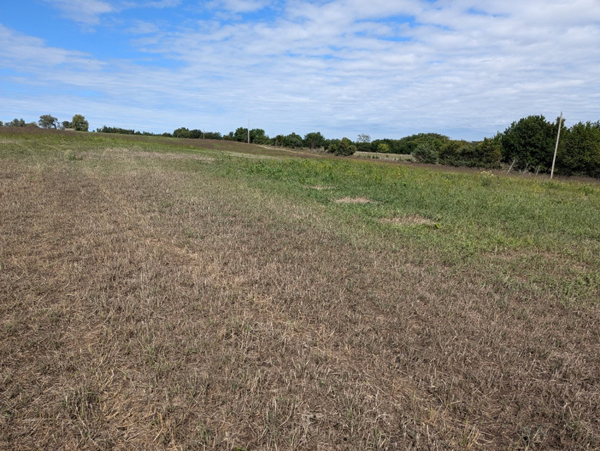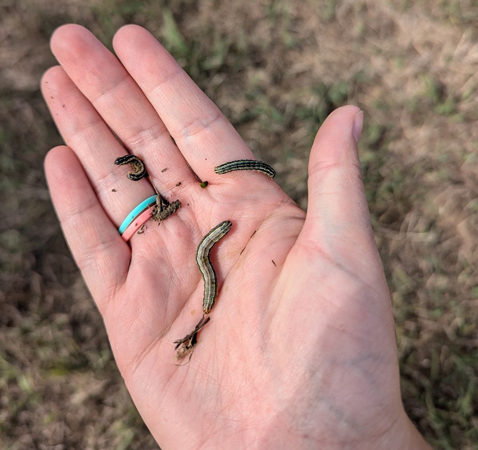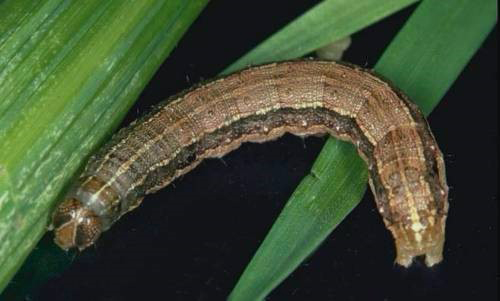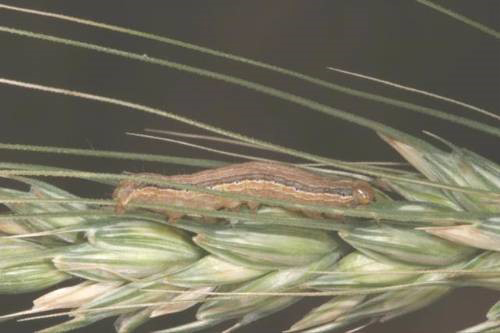Fall Armyworm, Spodoptera frugiperda, can damage several key Kansas crops as well as pasture, turf, and home landscaping. This insect does not overwinter in Kansas. Rather, it is native to the tropical regions of the western hemisphere and is active year-round along the Gulf Coast and southern Florida, migrating in from these locations each year. Two full generations are possible in Kansas, with defoliation and grain damage being the biggest concerns. Each generation’s abundance and distribution across the landscape are usually different; the first generation does not necessarily impact the abundance of the second generation. Feeding damage from fall armyworm during the vegetative stage in corn and sorghum causes chewed-up and ragged-looking leaves. In fact, one of the common names used for fall armyworm during this stage is “ragworm”. Sorghum is particularly at risk during grain fill, as fall armyworm will completely consume berries as they develop. This caterpillar has been causing increased concern in eastern Kansas brome fields over the last couple of seasons. Brome fields can rapidly decline from fall armyworm feeding (Figure 1) as large numbers of caterpillars can be present, consuming leaf material. Often, larger caterpillars are found along with younger ones.

Figure 1. Brome field damaged by fall armyworm caterpillars. Photo by Tina Sullivan, K-State Research and Extension.
Fall armyworm tends to begin arriving in Kansas towards the end of June, so scouting should start for this pest in at-risk crops and on a weekly basis for the remainder of the growing season. Caterpillars increase in size at an exponential rate, and most of the feeding occurs during the later stage of development. It is critical to scout early and treat, if needed, when the caterpillars are less than an inch long. Larger caterpillars are harder to control and do the most damage. Often, infestations are discovered after it is too late to treat. Recommended thresholds can be found below.
Fall Armyworm Thresholds
- Alfalfa: 1-2 caterpillars per square foot can destroy seedling alfalfa. 10-15 per square foot can destroy 12” tall plants.
- Corn: Damage to the whorl stage in early summer is typically not a concern and will not impact yield. Bt corn may prevent ear damage.
- Sorghum: Damage to the whorl stage in early summer is typically not a concern. 1-2 larvae/head during flowering to soft dough reduces yield by 5-10%.
- Wheat: Larval “window-paning” in early planted wheat can be a concern. Very late second-generation fall armyworm will be the biggest concern for wheat. If 25-30% of plants show damage, examine the field frequently. Treat at 2-3 active larvae/ft.
- Pasture/Brome: If damage is notable or there is window-paning, treatment may be warranted with 4 to 5 caterpillars per square foot.
Since fall armyworm is present for several months of the growing season, it is possible that sometimes mixed infestations of different caterpillar species can occur (Figure 2). As with any pest, proper identification is important to ensure that the right control recommendations are followed. A species often confused with fall armyworm is true armyworm, Pseudaletia unipuncta. The two species can be told apart with a couple of easily seen characteristics. Fall armyworm has a noticeable inverted “Y” on its head (Figure 3), while true armyworm does not. Additionally, the thickest stripe on the side of the fall armyworm caterpillar will be dark, while on true armyworm the thickest stripe is tan to orange (Figure 4).

Figure 2. Caterpillars were found damaging a brome field. Infestations can often include multiple species and multiple life stages. Photo by Tina Sullivan, K-State Research and Extension.

Figure 3. Fall armyworm, notice the thickest stripe is black. Photo courtesy K-State Entomology Department.

Figure 4. True armyworm, notice the thickest stripe is a light color. Photo courtesy K-State Entomology Department.
For more information regarding fall armyworm management, take a look at the following Insect Pest Management Guides:
Corn Insect Pest Management - https://bookstore.ksre.ksu.edu/pubs/corn-insect-pest-management-2025_MF810.pdf
Sorghum Insect Pest Management - https://bookstore.ksre.ksu.edu/pubs/sorghum-insect-pest-management-2025_MF742.pdf
Wheat Insect Pest Management - https://bookstore.ksre.ksu.edu/pubs/wheat-insect-pest-management-2025_MF745.pdf
Anthony Zukoff, Extension Entomology, Western Kansas Research and Extension
azukoff@ksu.edu
Tina Sullivan, Northeast Area Agronomist
tsullivan@ksu.edu
Tags: insects bromegrass fall armyworms